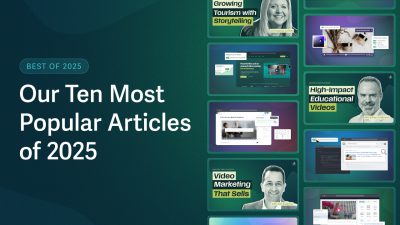The one key ingredient to any successful marketing video is an effective call-to-action (CTA). A persuasive CTA allows you to strike while the iron is hot, when viewers are most engaged and intrigued by your solutions. Here are the details on why they are so important, and how to implement your own powerful CTAs.
Creating a Targeted CTA
Persuasive calls to action are the backbone of good marketing campaigns. A call-to-action is usually the specific action you want a person to take after viewing your marketing campaign. Usually, CTAs are images or prompts that ask visitors to take a further action. For instance, adding an item to a cart, visiting a company website, making a donation, subscribing, or learning more about a product.
The right CTA depends on your goals for your campaign. Are you looking to grow your email list? Increase sales? Expand your reach on social media?
Defining your goal specifically and narrowly will help ensure your CTA is effective. Limit yourself to one main goal per campaign. Otherwise, your audience may not be sure of what the next steps are, and as a result, won’t do anything.
Don’t be afraid to make your CTA stand out. It should be memorable and prominent. The easier it is to understand and remember, the more likely your audience will be to act.
CTA Features in the SproutVideo Player
SproutVideo offers three main ways to implement a CTA in the player: before a viewer starts watching, during playback, and after a video concludes.
Before a Video Starts
Require viewers to submit their contact information if you want to use your video to grow leads. Use the copy on the page and the text on the form to make the value proposition clear so they know what they’re signing up for and what they’ll get out of their experience.
During Playback
Display a CTA during your video at just the right moment by adding text and a link to the landing page of your choice. The text is displayed in the upper righthand corner of the player and can be added at any time during your video or live stream.
After Your Video or Live Stream Concludes
Once your video is over, keep the enthusiasm moving by showing viewers a post-play CTA. You can either add text and a link, or use custom HTML to display a form or survey – whatever fits your campaign.
Why Rally the Troops with Video?
A viewer who makes it to the end of a video is a marketer’s dream. They are highly engaged and interested by your content. If they’re watching your video to the end, you also have some insight into what goods or services they’re interested in. This is the perfect opportunity for converting a viewer into a customer.
CTAs help keep audiences engaged, which is especially critical online, since viewers are often highly distracted with short attention spans. Instead of bouncing off the page, CTA buttons keep visitors clicking on your content — not clicking off to other destinations.
While you may understand the importance of CTAs, you may still be scratching your head as to how you’ll incorporate them into your videos. Don’t worry – read on!
Elements of Effective Calls to Action
Effective CTA are like a persuasive speech, thoughtfully crafted to inspire action. With only seconds to capture a visitor’s attention, a good CTA will make a given behavior seem natural for a visitor. But, those seconds can make creating CTA tricky.
1. Action
The first rule of creating a good CTA is to keep the ‘Action’ in ‘Call to Action’. Be direct, simple, concise, and strong. Use robust language to indicate to your audience what it is you want them to do. Why ask a potential customer to ‘click’ when you can ask them to ‘watch’ or ‘download’? Why ‘try’ a service when you can ‘get started today’? According to Hubspot, Firefox increased conversion rate by 3.6% when the company began using stronger language in their CTA’s.
2. Value
CTA should create value in your product. CTA tell prospective customers what your product is going to do for them. Use numbers. We automatically attribute credibility to statistics and mathematical proof. Take the opportunity to differentiate yourself from your competitors. “Visit our site. See why over 2 million people are using this service.”
3. Prominent
Make your CTA stand out visually and linguistically. Use language to your advantage. Clever, creative language is persuasive and interesting. Space is limited when it comes to CTAs, so the words you have should engage and excite visitors. Maximizing sensory and emotional appeals, asking questions, including testimonials, and using humor are all good linguistic strategies. Further, make sure you’re carefully thinking about how to make your CFA visually appealing. Color, size, and page position can have dramatic results on click-through.
4. Urgency
Good CTA impart a sense of urgency on the audience. Why click today when you can click tomorrow? Because the audience feels they have to. When you ask a visitor to ‘Act today’, you’re suggesting that tomorrow may be too late to take advantage of the promotion. Seasonal products may be limited in quantities. Creating urgency will translate into conversion.
5. Time
CTA are also successful when they appeal to the consumer’s time. CTA should show how quickly an act can be performed or easy the action is to do. Maybe it only takes seconds to download the program or payment can easily be made through a service like PayPal. Free trials are another example of appeals to ease. Free trials allow potential customers to try products without the constraints of commitment.
Inspiration for Calls-To-Action
CTA should reflect your marketing and business goals, and should be tailored to your product or service. These appeals aren’t just about driving sales or prompting customers to buy a service; CTA serve a number of purposes. Here are a few examples of how you can use CTA:
1. Purchase-related Actions
Simply, purchase-related CTA are designed to persuade visitors to purchase products.
- Add to cart
- Buy now
- Shopping cart icons
2. Subscription Actions
These CTA generate leads and increase your consumer audience. Subscription CTA ask visitors to become part of a mailing list, subscribe to newsletters, or receive services.
- Sign up
- Subscribe
3. Informative Actions
CTAs that fall into this category encourage visitors to learn more about a product, brand, organization, or event. These CTAs redirect the audience to additional information, often sending them to a website after giving the audience teaser information.
- Learn more
- Look inside
- Read more
- Watch the video
4. Promoting Trials
Usually free, trials are interactive CTAs that encourage customers to explore a product or service before purchasing it.
5. Downloading
Similar to purchasing actions, CTAs that ask visitors to download a product or service are encouraging ownership.
Coupling your video with a post-video CTA can have a tremendous impact on your conversion rates. These are just a few considerations when it comes to creating CTA and luckily there’s a lot of really good information out there to help you along the way.
Let us know in the Comment section below, on Facebook, or on Twitter @SproutVideo what’s important to you when determining your calls to action.








